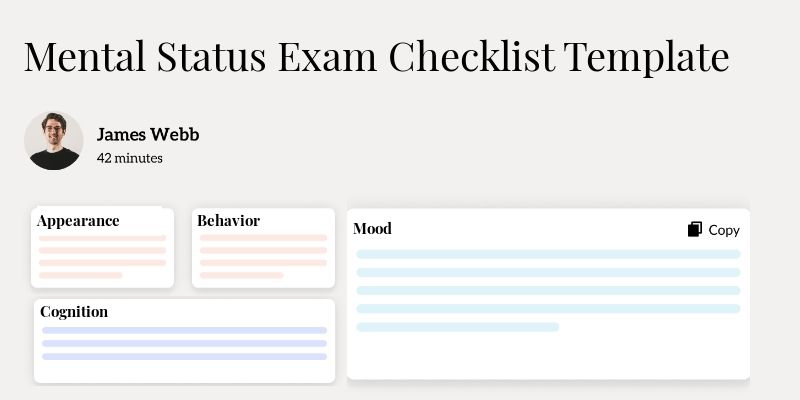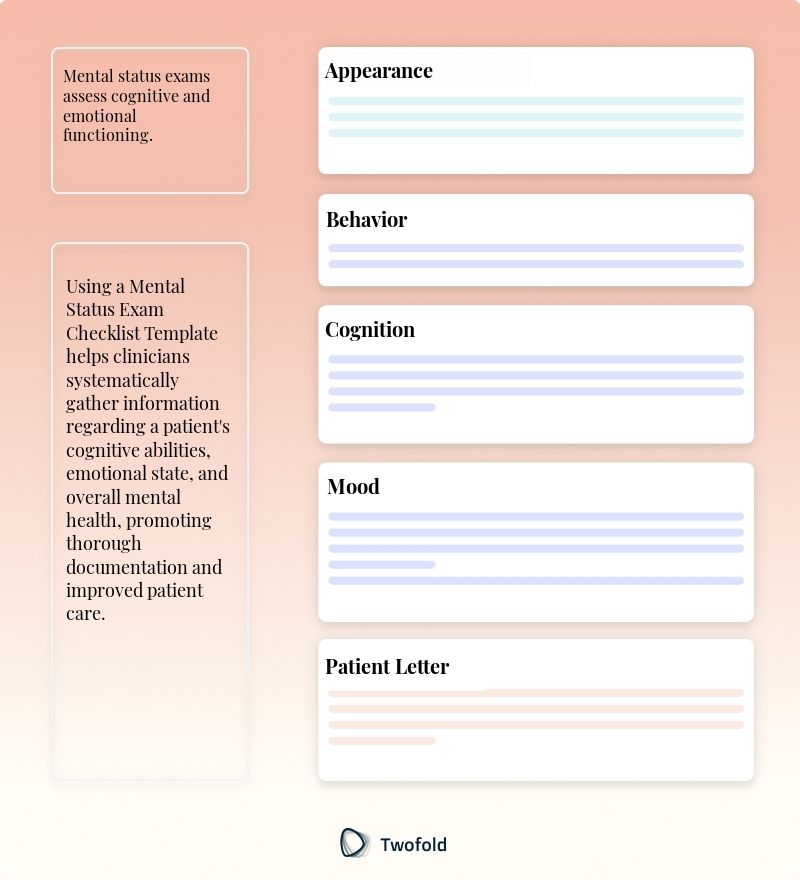
Mental Status Exam Checklist Template
Picture this: you're a professional navigating the intricacies of mental health assessments. Balancing numerous factors to reach a coherent diagnosis demands precision and structure. In such scenarios, what you need is a reliable tool to streamline the process. This is where the Mental Status Exam Checklist Template comes into play. It's your go‑to resource for efficiently conducting thorough evaluations.
What Is a Mental Status Exam Checklist Template?
The Mental Status Exam (MSE) Checklist Template is a structured tool used by healthcare professionals to evaluate a patient's cognitive functions. It helps ensure comprehensive coverage of the patient's mental and emotional health.
This template facilitates the organization of observations and data, allowing clinicians to efficiently document elements such as appearance, behavior, mood, and thought processes. Using a structured format improves the accuracy and thoroughness of mental health assessments.
Key Components of a Mental Status Exam?
The components of an MSE are broad but essential for thorough documentation:
- Appearance and Behavior
- Speech and Language
- Mood and Affect
- Thought Process and Content
- Perception
- Cognition
- Insight and Judgment

How to Use a Mental Status Exam Checklist Template: Step-by-Step Process
Step 1: Prepare the Environment
Ensure a safe and comfortable setting for the patient to encourage open communication.
Step 2: Conduct Initial Observations
Begin with observing the patient’s appearance and behavior, noting any peculiarities or notable features.
Step 3: Engage in Dialogue
Discuss with the patient, noting their speech patterns and the content of their conversation.
Step 4: Assess Mood and Affect
Document the patient's expressed mood and appropriateness of their emotional responses.
Step 5: Evaluate Cognitive Functions
Test cognitive abilities such as memory, concentration, and abstract thinking.
Step 6: Record Insights and Conclusions
Finish the assessment by documenting insights, potential diagnoses, and recommendations.
Benefits of a Mental Status Exam
Benefit | Explanation |
|---|---|
Consistency | Facilitates uniform documentation across patients, enhancing comparative analysis |
Efficient Assessment | Reduces time spent on evaluations while maintaining thoroughness |
Accuracy | Minimizes omissions through a structured approach, ensuring crucial details are recorded |
Legal Protection | Provides comprehensive records that can be critical in legal scenarios |
Stakeholders in Mental Status Exam
Several key stakeholders find value in the use of an MSE template:
- Psychiatrists: For instance, Dr. Blake uses the MSE template to streamline his patient evaluations and ensure no vital detail is overlooked in complex cases.
- Psychologists: Claire, a clinical psychologist, employs the MSE checklist to support her therapeutic assessments and treatment plans.
- Nurses: Registered nurse Hannah uses it for preliminary mental health screenings, aiding in decision-making for further psychiatric evaluation.
Example of a Mental Status Exam PDF
An example PDF of a Mental Status Exam can showcase the structured layout and detailed nature of the document, aiding practitioners in understanding its practical application.
Real-World Use Cases: Practical Impact of the Mental Status Exam Template
In practice, the MSE template proves invaluable in numerous scenarios:
- Hospital Settings: Dr. Lee employs the template in acute psychiatric wards to quickly assess patient progress and adjust treatment plans.
- Outpatient Clinics: Sarah, a mental health counsellor, relies on the template for initial evaluations to tailor her counseling strategies effectively.
- Community Health Services: At a community clinic, the template aids volunteers in triaging patients, ensuring those with severe issues are seen promptly by specialists.
Conclusion
The Mental Status Exam Checklist Template is a vital tool in mental healthcare, providing structure and clarity in complex evaluations. By ensuring comprehensive documentation, it supports practitioners in delivering accurate assessments and high‑quality care. The value of the MSE template extends from inpatient settings to community health services, underscoring its versatility and critical role in psychiatric evaluations.
Disclaimer: This article is for informational purposes only and does not constitute legal or medical advice. Always consult professional guidelines and regulatory bodies for specific compliance requirements.

Dr. Danni Steimberg
Dr. Danni Steimberg is a pediatrician at Schneider Children’s Medical Center with extensive experience in patient care, medical education, and healthcare innovation. He earned his MD from Semmelweis University and has worked at Kaplan Medical Center and Sheba Medical Center.
An MSE is a rapid, structured snapshot. Use one pass ‑ Observe, Ask, Test ‑ across the 10 core domains to keep notes fast, consistent, and clinically defensible.
- Observe first: Before questions, check boxes for appearance, attitude, psychomotor activity, speech, and affect. Use “adjective + example” entries (e.g., “disheveled - food stains”) and note affect-mood congruence.
- Ask for content and risk: Capture mood in quotes, thought process, and thought content including SI/HI/AVH. If SI is present, document plan-intent-means-protective factors; if denied, record “SI/HI/AVH - denies; acute risk low; safety plan reviewed.”
- Test cognition efficiently: Log orientation (person-place-time-situation), attention (months backward or WORLD), memory (3-word recall), and one executive task. Record scores and any aids used to make changes over time obvious.
Frequently Asked Questions
Reduce burnout,
improve patient care.
Join thousands of clinicians already using AI to become more efficient.

Notice of Privacy Practices Template
Discover practical Notice of Privacy Practices Template templates to enhance your documentation efficiency.

Mental Health Intake Assessment Template
Discover practical Mental Health Intake Assessment templates to enhance your documentation efficiency.

Care Coordination Plan Template
Discover practical Care Coordination Plan templates to enhance your documentation efficiency.

